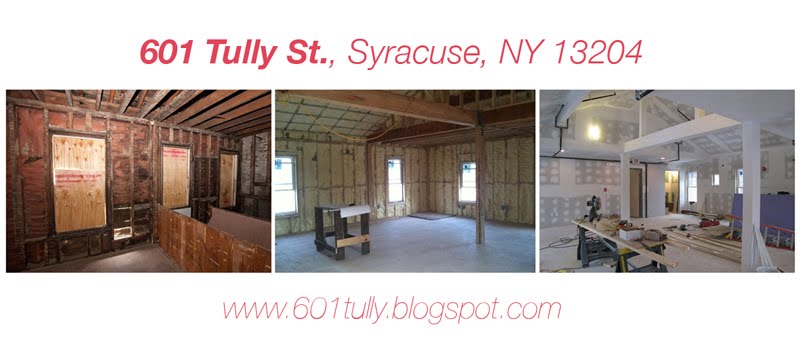About 601 Tully
Check out our new website! 601Tully.syr.edu
601 Tully is a center for engaged practice in Syracuse, NY developed by artist and professor Marion Wilson with a rotating collaborative team of 54 students and neighbors and Anda French of French 2Design. It's a site for meaningful exchange between artists, community members, and scholars in the co-production of culture.
601 Tully includes a contemporary art space, a public events space, a bookstore, a teaching garden, and Recess Cafe West.
In 2009, Wilson purchased the condemned two-story home and local drug hub, and throughout five semesters, Wilson's design/build class re-zoned, designed, renovated and now sustains the physical and programmatic aspects of 601 Tully. The collaborative team has consisted of artists, architects, environmentalists, Fowler High School students, Green Train Workforce, neighbors, and the occasional passerby.
601 Tully is made possible by the generous support of the Syracuse University School of Education, The Kauffman Foundation, The Near West Side Initiative, Imagining America, Home HeadQuarters Inc., Say Yes to Education, and National Grid.
Find us on Facebook!
Sunday, February 21, 2010
Article
Maltzan makes a series of bold cuts through other parts of the building, creating surprising visual connections to the world outside. A counter in the communal kitchen, for example, lines up with a slot that runs diagonally through the entire ground floor, framing views of the freeway’s underbelly on one end and back toward Skid Row on the other.
The most unexpected of these views is in the laundry and community room on the third floor. Conceived as the building’s domestic heart, the room overlooks a section of the elevated freeway through a long horizontal window. The window is made of acoustical glass, so that even at midday the noise is reduced to a soft hum. But it is so close to the passing cars that at rush hour, when traffic is barely moving, tenants and drivers can make direct and prolonged eye contact. Late at night, when the freeway is nearly empty, the cars flow by in a dreamy rhythm.
It’s a witty, even poetic moment, one that captures the dueling essences of Los Angeles: the promise of freedom and opportunity embodied by its freeways and the degree to which that promise has turned out to be a fantasy.

No comments:
Post a Comment